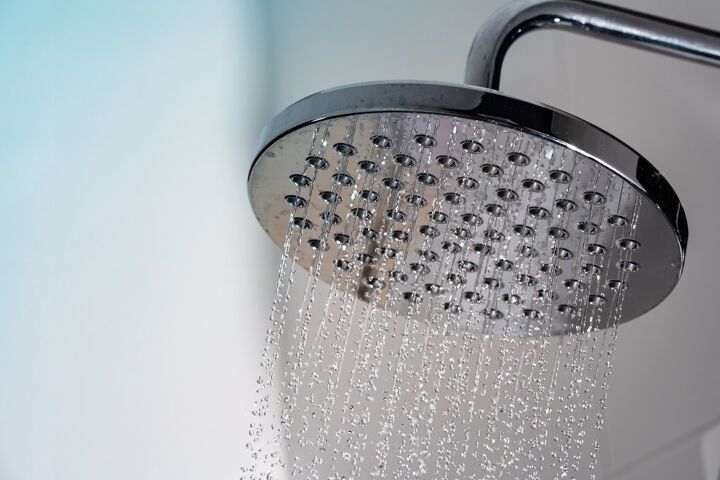Is A Rainshower Head Right For You? (Find Out Now!)

Rainshower heads transform an ordinary bathroom into an extraordinary spa experience. The fixtures have an aesthetic and functional appeal that is hard to resist.
We recommend rainshower heads for larger showers. They produce a relaxing, cascading spray pattern that simplifies bathing. The fixtures are easy to install and clean, and they have many special features. The downside of a rainshower head is that it needs to be mounted at a 90° angle from the wall and higher than standard showerheads. The fixtures are also more expensive than standard showerheads.
Knowing the pros and cons of rainshower heads helps you decide if this bathroom upgrade is right for you. Let’s take a closer look at rainshower heads, how they work, and the pros and cons.
Do You Need a Faucet, Fixture, or Pipe Repair or Replacement?
Get free, zero-commitment quotes from pro contractors near you.

What is a Rainshower Head?
Measuring between 6” and 12” in diameter, a rainshower head is about twice the size of a standard shower head. The greater surface area means that a rainshower head distributes a larger pattern of water. This translates into better coverage during your showers. Instead of moving around to use the shower, you can stand in one place to do your bathing. Rainshower heads also create a soothing cascade of water that is very relaxing.
How Do Rainshower Heads Work?
Rainshower heads work in the same way as standard shower heads. Water travels through your plumbing pipes and comes out of the holes in the shower head. The primary difference between rainshower heads and standard shower heads is the way in which way is distributed from the head.
Types of Rainshower Heads
There are several types of rainshower heads available, including single rainshower heads, rainshower heads with wands, rainshower head combos, and rainshower head systems.
Single Rainshower Heads
Single rainshower heads can be mounted in the ceiling or on the wall. You have only one fixture for showering.
Rainshower Heads with Wands
Rainshower heads with wands are installed on the wall and held in place with a mounting bracket. The fixture has a tube that connects to the plumbing pipe on one end and the showerhead on the other end. You can remove the showerhead from the mounting bracket while showering.
Rainshower Head Combos
Also known as dual shower heads, rainshower head combos have two shower heads. The rainshower head is connected to a tube, much like a rainshower head with a wand, and a second smaller shower head is fixed in place on the mounting bracket.
Rainshower Head Systems
Rather than having individual rainshower fixtures, a rainshower head system is designed with multiple outports for the water. The system may have outports on the wall and ceiling, and you can design your bathroom with one or more rainshower systems in the shower stall.
Pros of Rainshower Heads
Rainshower heads offer many advantages over standard shower heads.
- Spa Environment: The appearance and function of a rainshower head creates a tranquil escape from the hectic pace of modern life.
- Complete Coverage: Rainshower heads distribute water to cover the entire body – no more dancing around the shower to get clean.
- Ease of Maintenance: The simple design of rainshower heads make them very easy to clean – very few nooks and crannies for hard water deposits and soap residue.
- Easy Installation: With the exception of ceiling-mounted rainshower heads and rainshower systems, you can easily replace your standard wall-mounted shower head with a rainshower fixture.
- Nice Range of Features: Some models of rainshower heads come with special features, such as touch control, different spray patterns, swivels, and even WiFi connection to Amazon Alexa or Google Home.
Cons of Rainshower Heads
Disadvantages of rainshower heads are:
- Expensive: Rainshower heads are more expensive than standard shower heads in both the cost of the fixture and installation if you are going for a ceiling mount or system.
- Ceiling Height: A nice rainshower effect is only as good as the height of your ceiling – rainshower heads needs to be mounted at least 80” to 84” from the floor of your shower or 12” higher than the tallest person in your home.
- Installation Angle: Water cascades from a rainshower head, and this requires that the fixture be mounted at 90° – otherwise the water will only come out of one side of the head.
- Low Pressure: Rainshower heads are designed for low pressure showers – some models have adjustments for water pressure, but not all.
- Messy: Rainshower heads have larger spray patterns, and the water may get on the floors of your bathroom if you don’t have a large shower stall or shower door.
How to Install a Rainshower Head
Rainshower heads connect to a 1/2” plumbing pipe the same as standard shower heads. For a true rainshower effect from a wall-mounted model, add a pipe extension to keep the face of the showerhead parallel with the floor of your shower. If you are mounting a rainshower head from the ceiling, have a plumber extend the plumbing pipes inside the walls of your shower. For multiple rainshower heads and rainshower systems, have a plumber add pipes to the existing shower configuration.
How to Fix a Rainshower Head
There are some common problems with rainshower heads.
Leaking at the Threads
The most common problem with a rainshower head is leaking at the threads. Twist the head in a counterclockwise direction to remove it from the plumbing pipe. Replace broken gaskets. Wrap the end of the pipe with sealant tape, and reinstall the fixture.
Uneven Spray Pattern
If you have an uneven spray pattern from your rainshower head, clean the openings. Use a mild cleaning product that won’t scratch the finish. You can also use a product that removes hard water deposits.
Low Water Pressure
Low water pressure from a rainshower head is either due to the design or the main water valve setting. Try increasing the water pressure by turning the plumbing water valve clockwise. If the water pressure is till too low for a good shower, replace the showerhead with a model that has adjustable pressure settings.
Signs That You Need to Replace Your Rainshower Head
Rainshower heads are built with exceptional quality that contributes to the high-end aesthetics of the fixtures. The fixtures do wear out like any other fixture in your bathroom. Here are the most common signs that it’s time for a new rainshower head.
- Inconsistent Water Pressure: If you notice that the water pressure changes during your showers, the components of the rainshower head may be breaking down.
- Uncomfortable Showers: If you feel like you aren’t getting clean or don’t like the experience of your rainshower head, it’s time to replace the fixture.
- Children Showering: When your children start to shower on their own, consider replacing a rainshower head with a standard shower head. Learning to shower alone can be an overwhelming experience for youngsters, and a rainshower head may make your children a bit more uncomfortable.
- Hard Water Deposits: Hard water deposits in rainshower heads clog the openings and create an uneven spray pattern. If you have tried to clean the openings with no luck, replace the fixture.
Related Questions
What is the best rainshower head height?
Rainshower heads are installed 80” to 84” from the floor of the shower or at least 12” higher than the tallest person. The head needs to be at a 90° angle and parallel to the floor of the shower for the best effect.
Can I install a rainshower head on a standard shower faucet?
Yes. Rainshower heads use the same 1/2” connection as standard shower heads. You may need an extension pipe to install the rainshower head at a 90° angle.
Do rainshower heads use more water?
No. Rainshower heads use the same amount of water as standard shower heads. The difference is not in how much water is used, but the spray pattern of the showerhead. You may use more water for your showers with a rainshower head because you spend more time in the shower, but it is not because of the design of the head.
Do rainshower heads tilt?
Yes. You can find rainshower heads that swivel and tilt.
Do You Need a Faucet, Fixture, or Pipe Repair or Replacement?
Get free, zero-commitment quotes from pro contractors near you.

What Did We Learn?
Rainshower heads come in many styles, and can be mounted on the wall or from the ceiling. Wall-mounted models are good replacements for standard shower heads, so you can have a rainshower head even if you live in a rented property. Wall-mounted models can attach directly to the wall, or you can find models with wands and dual shower heads. For a complete bathroom transformation, choose a ceiling-mounted rainshower head or rainshower system.
Rainshower heads have some appealing upsides, as well as downsides that may not make the additional cost worthwhile. The primary appeal of rainshower heads is the cascading pattern of water that is relaxing and soothing. Rainshower heads also give any bathroom an upscale, elegant look.
The downsides of rainshower heads are the cost and plumbing modifications if you are moving from a wall-mounted fixture to a ceiling mount or rainshower head system. Some people find that the water pressure from a rainshower head is too low to feel completely clean. Rainshower heads can be messy if you have a smaller shower stall or no shower door.
Related Guides

Jennifer L. Eggerton loves being hands-on, whether it's with a home DIY project, making repairs, re-decorating a room, or keeping life organized. She enjoys helping people by sharing her knowledge, insights, and experiences, as well as her lessons learned. In addition to her work as a writer, Jennifer is a Jeep® overlander, self-published author, and nature photographer who loves being outdoors.
More by Jennifer Eggerton


























![How To Reset A Whirlpool Cabrio Washer [In 5 Easy Steps!]](https://cdn-fastly.upgradedhome.com/media/2023/07/31/9076531/how-to-reset-a-whirlpool-cabrio-washer-in-5-easy-steps.jpg?size=350x220)
